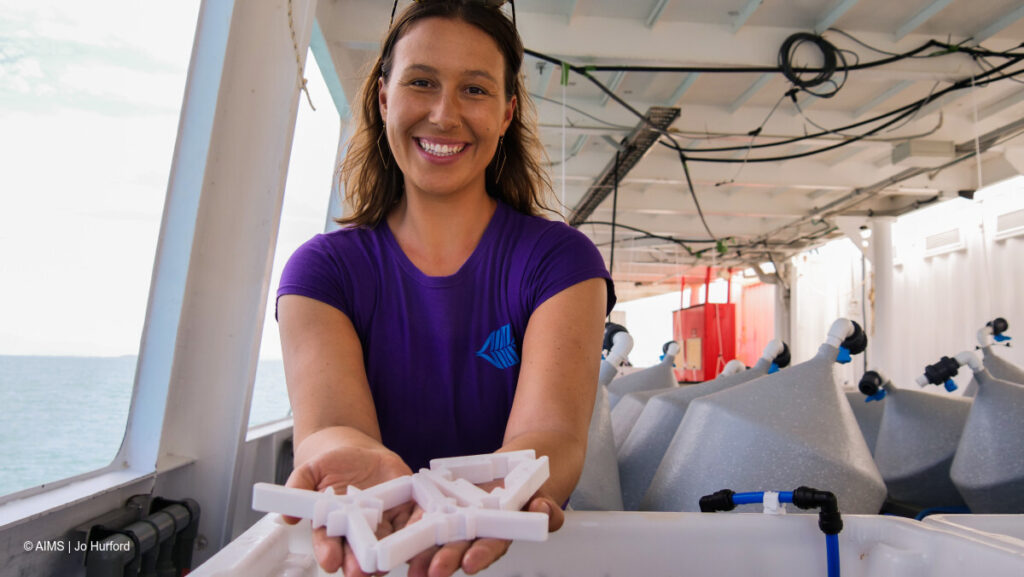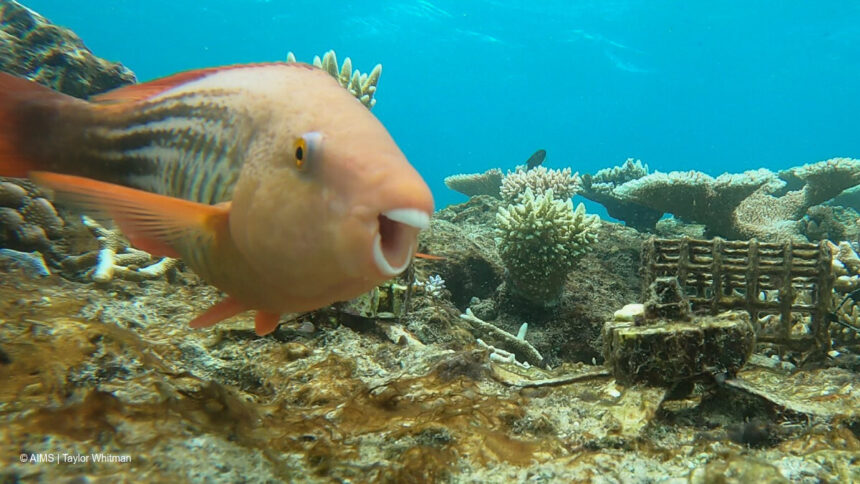

For immediate release: Thursday 18 July 2024
Scientists from the Australian Institute of Marine Science (AIMS) and James Cook University (JCU) have designed special cradles for baby corals that help prevent fish from eating them alive.
The tiny corals are directly or indirectly eaten by common reef dwellers like parrotfish, who graze and excavate the reef surface as they feed.
In a new paper for Scientific Reports, the researchers field tested the cradles – or devices, finding young corals survived best on devices which were engineered with protrusions. These were found to protect the growing corals in small crevices because they helped to reduce the incidence of fish bites.
Survival in the protection devices was similar to devices that were fully protected by a cage.
Scientists at AIMS, alongside their collaborators from the Reef Restoration and Adaptation Program (RRAP), have been researching the process of coral seeding, which involves raising young corals in an aquaculture facility, like the National Sea Simulator in AIMS Townsville. Coral larvae are settled onto special tiles that are slotted into devices which are then placed onto the Great Barrier Reef.
Lead author Taylor Whitman said the experiments are part of efforts to understand how best to help coral reefs recover from disturbance events like coral bleaching, which can damage and kill corals.
“Young corals need all the help they can get in their early years because mortality rates are high. Designing devices that can help boost their survival is just one of many aspects of reef rehabilitation we are studying at AIMS,” she said.
“We need to find solutions that are effective at reducing the risk of predation on seeded corals, while also providing some access so the fish can graze and maintain the balance between the coral and competitive algae that also grow on the devices. We need to look at solutions that are scalable and not too labour intensive, while taking into account the differing environmental conditions on the reef. It’s a complex challenge!”
Ms Whitman and the team seeded nearly 350 devices harbouring baby corals and small pieces (microfragments) of corals onto Davies Reef, near Townsville for eight months. Some of the devices featured no protection while some were completely caged off and others were partially protected with engineered protrusions built into the devices.
They then surveyed the devices after two days, three months and eight months, checking for grazing marks and surviving corals. They also collected data on the biological and environmental conditions of the reef to better understand the device performance.
The scientists found that the devices with built in features offered a simple and effective way of reducing grazing pressure that was cheaper and more scalable than cages. Most corals seeded without protection suffered mortality within 24 hours.
Ms Whitman added: “The orientation of corals in devices also had a major influence on survival. Coral larvae often preferentially settle on vertical surfaces to reduce the impact of environmental conditions like high light and turbulent water flow. Our study shows that this vertical orientation can also provide shelter to corals from grazing fish. We found more corals alive in side-facing than top-facing orientations, and under certain ecological conditions, some vertically positioned corals survived without protection.
“An abundance of food for the grazing fish also seemed to help our seeded corals. Locations with nutritious algae (including cyanobacteria) or hard corals resulted in less attention from the parrotfish on our babies.”
Co-author and AIMS senior research scientist Dr Carly Randall said there is still room to improve the design of the devices by better understanding their interaction with the environment.
“Coral seeding shows promise as a scalable intervention to help coral reefs as the planet warms under climate change,” she said.
“This research, through the Reef Restoration and Adaptation Program consortium, shows that we are on our way to improving how we can support the corals we seed to survive their first year of life, while they are extremely vulnerable.”
Reef Restoration and Adaptation Program Executive Director Dr Cedric Robillot said: “The speed at which climate change impacts are unfolding on coral reefs around the world is alarming and current restoration efforts can’t keep up. We must pioneer a toolkit of solutions that are both inexpensive and scalable to help protect and restore these precious ecosystems.
“These coral seeding devices are game changing as they are designed to be deployed from the surface and without divers across large areas of reef. It completely transcends current notions of coral reef repair, which are mostly done by hand across small areas.”
Primary funding for this study was provided by the Reef Restoration and Adaptation Program (RRAP), a partnership between the Australian Government’s Reef Trust and the Great Barrier Reef Foundation.
Supplementary funding was provided from three grants awarded to Ms Whitman by AIMS@JCU, the American Australian Association, and the Ecological Society of Australia.
Download images and vision here.
About us:
More about the Australian Institute of Marine Science:
The Australian Institute of Marine Science (AIMS) is Australia’s tropical marine research agency. In existence for half a century, it plays a pivotal role in providing large-scale, long-term and world-class research that helps governments, industry and the wider community to make informed decisions about the management of Australia’s marine estate. AIMS science leads to healthier marine ecosystems; economic, social and environmental benefits for all Australians; and protection of coral reefs from climate change. More here: https://www.aims.gov.au/
Contact details:
Jo Manning, Media Officer: media@aims.gov.au; +61 456 196845

